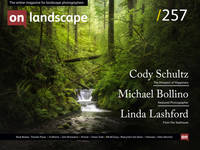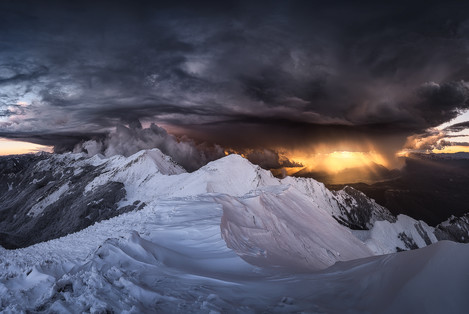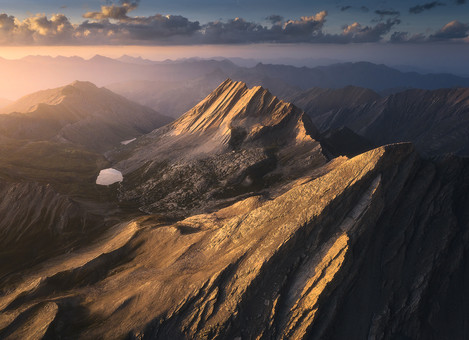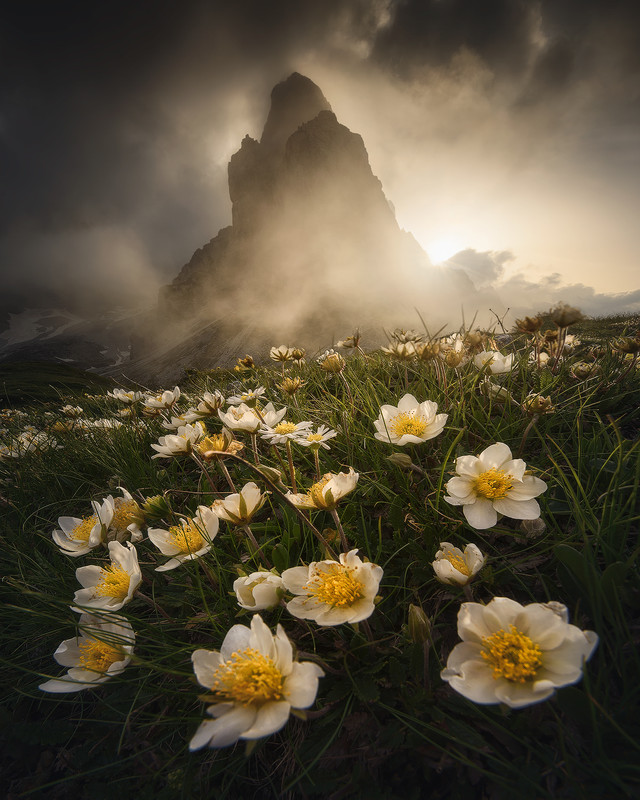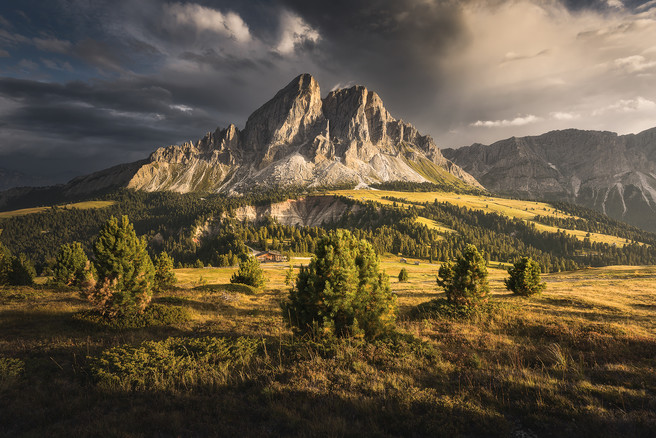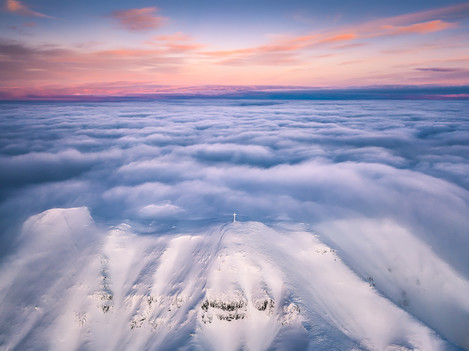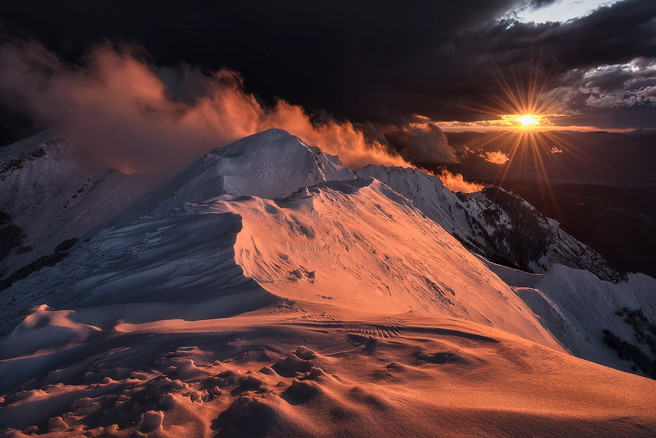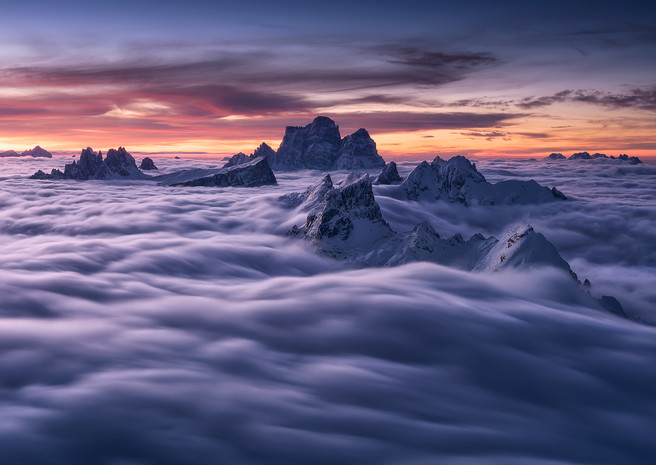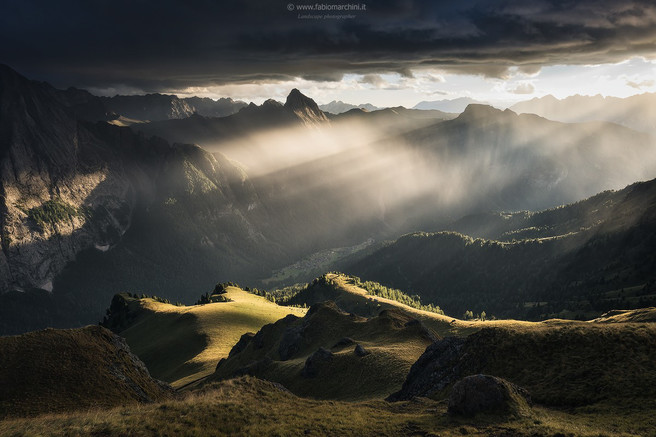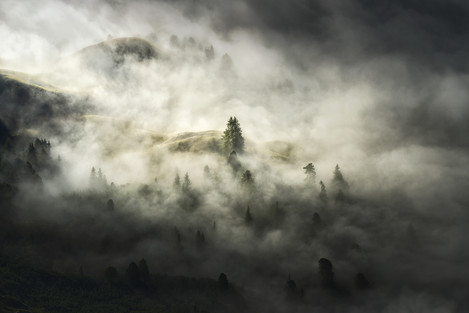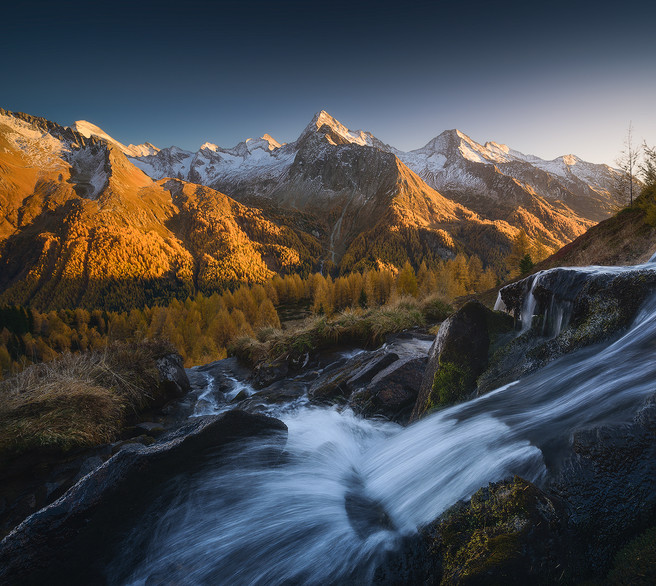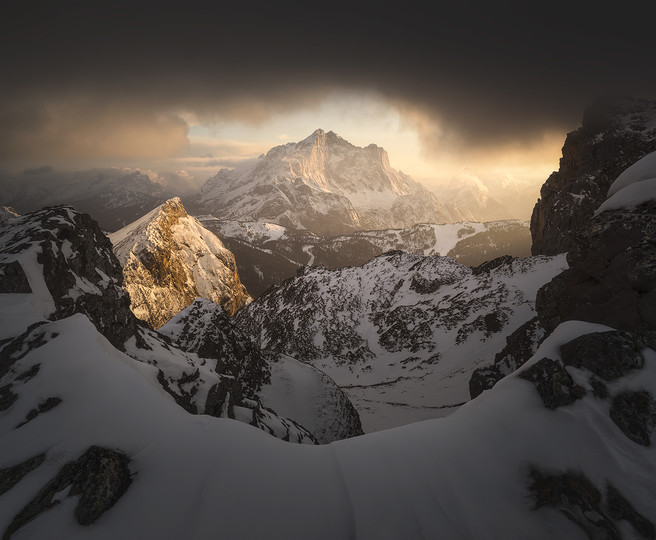Mountain Photography in the Dolomites

Fabio Marchini
I am a professional photographer specialising in landscape photography, a passion that I started to cultivate in 2011 which since 2015 I have transformed into my current profession. I have always lived in the province of Parma in northern Italy.
Most of my shots portray the natural mountain environment, especially the splendid Dolomites, a Unesco World Heritage site. These mountains that I have come to love and have frequented for over 15 years, first only as a hiker and then as a photographer. Photography represents for me a path of personal growth, a path where I can research my personal vision of places, and then represent and share them through my photographs in my own style.
I love the different aspects of photography, the desire to get involved, the research to get most out of the scenes and the result of those original ideas. I organise photographic workshops, individual courses and tours, and editing courses mainly using Adobe Photoshop.

Eelco Scheer
A wannabe outdoorsman passionate about photography based in the Netherlands. Unfortunately, I do not have enough time to pursue those passions full-time. Mountains, forests, and horses are my main photography topics but now-and-again I might look at something else. My main goal in photography is to share with others the beauty of what I see (or my perception thereof).
In this issue, we talk to Fabio Marchini from Italy. For numerous people, Italy is well known as a holiday destination. Especially the north of Italy, with the majestic Dolomites, holds a warm place in the hearts of many. For landscape photographers, the Dolomites could be considered part of heaven. Fabio has spent the last 15 years, of which 10 years professionally, photographing exactly this area.
Could you give us a bit of background about yourself and how you got into photography?
In my life I have always had different passions, as a boy up to the age of 20, I played football, then I dedicated myself to various other activities, like fitness and skiing. Not many signs of becoming a professional mountain photographer! My love for photography only started around the age of 23 when I bought my very first compact digital camera. The camera was just a small point-and-click camera to take souvenir shots during my mountain treks.
My real passion for photography was born in 2011 at the age of 28 when I bought my first digital reflex camera, a Nikon D90. I also consider that occasion to be the start of my growth as a photographer. Photography was a wonderful discovery for me, and I suddenly fell in love with it.
I have never studied photography, painting, or any visual art for that matter. I have developed my photography technique and vision over time, by trying to learn from the great landscape photographers that I have admired.
My passion for photography was born of my passion for the mountains. I can definitely say that the mountains have always been my muse. Going on treks in the mountains I discovered the pleasure of taking and bringing home images that could go beyond the simple souvenir photo. I wanted to become a professional photographer as I wanted to carry out a career that came with love, that fit and that could enhance my skills, not only artistic but above all personal.
My professional career in the world of photography started in 2016. I love my job, I like to teach and pass on my passion for photography to those who choose to come on workshops or take an online class with me.
What / who were your first influences/influencers and what do you remember about the images you made?
In the early days when I was making images, I didn't have any real references, but at that time I started attending a well-known photography forum in Italy, I started learning mainly thanks to the feedback and criticism I received on my images from other users.
I like to observe and try to grasp what can be a source of inspiration for me. To do this, the person doesn't necessarily need to be my favourite photographer, there are many aspects and facets in photography. This is why I consider it important to observe and analyse every shot that appears fascinating to our eyes regardless of who took it. I think that every good photographer has something to teach.
In Italy, there are many good photographers, but I want to mention Enrico Fossati as he has certainly been a reference for me all these years, even if we have quite different styles. To learn how to photograph and develop your own style, you must observe a lot and try to copy little.
Has anything remained a constant? Or has your photography changed over time?
My photography has changed a lot over time, and luckily so, I might add. Change is also synonymous with evolution, so it means that over time I have grown and consequently I have changed my approach to photography. For me, photography is a constantly evolving artistic and personal journey. What I have never changed is the kind of photography… I always photograph only landscapes.
Can you explain something about your passion for the mountains?
The mountains have always fascinated me, their shapes, their silence, their majesty, they always made my soul vibrate with emotions. Being in the mountains for me means feeling grateful for what I have in life. Whenever I find myself living and photographing certain landscapes, I feel very lucky and for this, I must be grateful to nature and to myself.
I started going to the mountains frequently at the age of 23, I have always done many treks, even quite demanding ones, but I have never practised mountaineering or other more extreme activities. One could say I was a mountain-addict long before I became a photographer. As soon as I discovered my passion for photography, I combined the two, and the two reinforced each other. As a result, I certainly discovered wanting to improve my photography and how magical it is to go to the mountains during sunrise and sunset times, and especially how early or late, that can be.
I have never taken courses in mountaineering or anything else, simply because I do not do anything extreme or difficult. To go to the mountains and do what I do, it is enough to be fit and to know the mountains and the different locations. Obviously, in 15 years of going to the mountains, I have also learned a lot of things from experience.
What should the reader understand about hiking and climbing (to keep safe and take the best pictures)?
Never improvise in the mountains! When escaping into the mountains it is of utmost importance to plan the route in line with your abilities and study the weather forecasts. As Conditions in the mountains can change very, very quickly. Not being prepared can be a risk too for your safety, not to mention the joy of taking photographs.
Be aware of thunderstorms. during the summer. These are certainly one of the most underestimated dangers by photographers and hikers…. It is not pleasant to be in a huge thunderstorm with lightning all around you. Take it from someone who tried it.
Of course, we shouldn’t forget that unusual circumstances also create rare opportunities for beautiful pictures. If you are in search of the right atmosphere, and you have doubt that a thunderstorm may occur, look for a location that offers shelter. This could be a cave or an emergency bivouac. In doing so you can go in search of the most spectacular conditions, without running into personal danger.
Except for the mountains, which obviously inspire you, are there any other areas where you seek inspiration or are motivated by?
I can sum it up by saying that I like wild nature, without a hint of reference to manmade work. I have a passion for the Nordic countries: Norway, Canada, and Alaska, just to name a few. These countries fascinate me because of their extensive wild lands, places where nature reigns supreme. The great landscapes of North America, for example, with coniferous forests, towering mountains, glaciers, and rushing rivers, are for me the true essence of wild nature.
Can you lead us through your portfolio using a couple of photographs and tell us why they are so special to you?
Between heaven and hell
I consider this to be my first “big photo” that I took after a year of photographing mountains, and it represents one of the most epic conditions I've ever witnessed in my life.
Lagazuoi
Lagazuoi is one of my favourite places in the heart of the Dolomites and this photo tells how spectacular this location can be.
Shower of light
This photo will always remind me of what it means to shoot after a storm… an incredible light that made that sunset something unforgettable.
Can you explain to the readers the philosophy behind your photography?
Photography for me is not just a passion, but a path of personal growth.
I think that in photography there is never a point of arrival, but only a continuous growth and evolution over the years. I certainly like to recognise myself in the photos I take. By this, I mean not only conveying the beauty of the places but also my philosophy, feelings and emotions I experience in those locations that I visit.
What kind of post-processing do you do on your photographs? Could you give us an idea of your workflow?
It is important to always remember that it is landscape photography we are practising. The result, however modified it may be, must in my opinion retain a certain naturality. Whoever observes our images must still find them realistic and natural regardless of the interventions carried out during the editing phase.
The first step is to perform general optimisation with Adobe Camera Raw. In Camera Raw, I try to choose the brightness that suits the picture best. Thereby trying to maintain details in the rather dark shadows and mid-tones, without giving too much weight to the more consistent shadows too much. Even from the chromatic perspective, I try to intervene to find the right colours and therefore make the shot as optimised as possible.
Once the general changes are made in Camera Raw this phase is completed and I move on to the next step in Photoshop. I use Photoshop mainly to apply local adjustments through dedicated masks. In Photoshop I almost never make a single adjustment that applies to the whole image, but I make multiple adjustments based on the various areas of interest. Interventions in Photoshop are done in a more targeted way, aimed at invoking changes in colour and putting and putting more, or less emphasis on specific (high)lights and shadows. It happens that multiple images need consistent targeted colour changes; Photoshop offers me the possibility to do them more effectively.
I use a creative post production, aimed at interpreting the individual images and according to my personal artistic vision. No picture is developed in the same manner, but development always differs based on the image I am developing. This doesn't mean I change my workflow, but it does change the way I use and dose the various techniques and adjustments. For that reason, I don't use presets.
Instead of the presets I use some very useful tools, such as the "Tonality mask" plug-in created by the Italian photographer Gaspare Silveri. This plug-in allows you, in addition to the classic luminosity mask, to create many masks quickly and intuitively according to your needs. The panel also has other interesting actions that are useful in developing images. Coming back to the shadows and highlights there are many techniques all very similar, leading to (slightly) different results.
Experience helps, you learn which tools suit you best and understand when to use one technique rather than another. Don’t let yourself be misled/fooled by the apparent ease some people display while editing a picture, hundreds of hours of trial and error, and as a result experience, is the foundation!
Can you explain what's in your backpack (both photography and unrelated to photography) and why?
In my camera backpack, I have the following equipment: Nikon D800, Nikon 14-24 f/2.8, Nikon 24-120 f/4, Sigma 100-400 f/5-6.3 and a Mavic 2 pro, and next to this all sorts of accessories. You will not find any filters in my bag as I find them highly impractical, and masks lead to the same results. Make sure you have fully charged spare batteries. If it is really cold, keep them as close to your body as possible. The cold will drain batteries quickly
I prefer to use zoom lenses because in landscape photography it is important to have a certain flexibility with focal lengths. Fixed focal lengths also tend to be heavier. When trekking, weight is an important factor in the equation. That same factor also comes into play choosing a tripod, is one of the reasons I chose a Sirui T-2204X.
I also use the Mavic drone because it allows you to have a unique view that would otherwise be impossible to attain. For me, the drone is like having an additional lens in the Landscape photographer’s backpack. I do not consider myself an aerial photographer but use the drone if I think attaining a higher point of view will add to the quality and visual impact of the image.
After all, not all locations are suitable for the use of a drone. Furthermore, to achieve shooting it is not enough to simply fly the drone and shoot from above. Taking good photographs is already difficult, photographing with the drone is even more complicated if you want to obtain pictures with the same quality and impact. For me, therefore, the drone is an extra work tool, which I use only when I think it allows me to really create a better picture given a certain interesting situation. I will not go flying the drone to find this context but to have something in mind and then conclude that flying the drone could give me an extra opportunity.
In addition to the photography equipment, I always carry a down jacket to wear once on site, a raincoat for obvious reasons, gloves, and a hat. The temperatures in the mountains can fluctuate tremendously, both in summer and in winter and treks can be quite demanding physically. To replenish the loss of fluids, water is also standard in the bag and my backpack is never missing a fresh shirt. For longer more demanding treks and overnights, I use an 80L hiking backpack, so that I can take food and everything I need for the night bivouac with me.
Which people inspire you photographically and why?
I have always tried to be inspired by the many good photographers that the web allows us to admire. I'm not used to picking out favourite photographers, but if you ask me who is one of the photographers I admire most, I would definitely say Marc Adamus, as he is a great adventurer and because he is one of the photographers in the world to have unique and exclusive images. He was the one who created a style from which amongst many others I take inspiration. In addition, he has a truly incredible photographic vision, for me, his work remains one of the reference points.
Adamus teaches me that to have exclusive images, you first have to be an explorer. In recent years, in my own small way, I have been trying to photographically explore still little-known places both in the Dolomites and beyond!
Over the last year I come to be very impressed by the shots of the photographer Filip Hrebenda. He has grown a lot and has come to consistently deliver pictures with very high-quality levels. He is in my opinion one of the top photographers of landscape photography despite, at the moment, he is still relatively little known. His photos are impeccable from all points of view, which is why I invite you to go and get familiar with his work.

